A collection of flyswatters?!? I haven’t given these tools much thought, but when Chuck, my husband, and I entered the Kalamazoo Valley Museum we were captivated by the display of flyswatters! Some hung from the ceiling in front of three glass cases filled with many styles of these pest controllers. The display featured a woman, Iza van Riemsdijk. This was her collection! Questions bubbled inside me. Why had she started collecting fly swatters? Was she from Kalamazoo? How many are there? I needed to investigate.
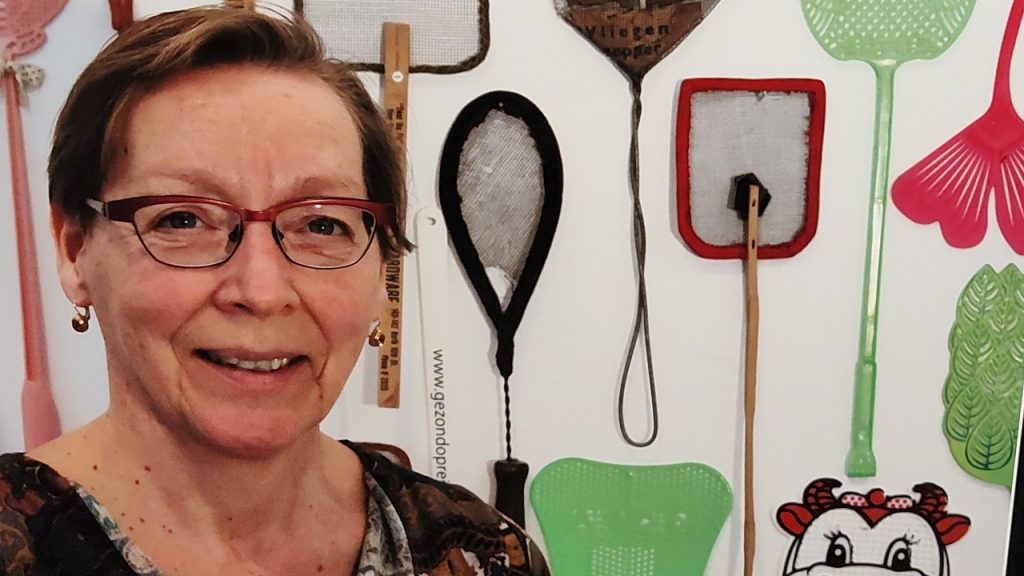
Photo Credit: Kalamazoo Valley Museum
How Did Iza Begin Her Collection
On a trip to Japan in 1989, Iza van Riemsdijk had been enthralled by a “soft pink flyswatter in the shape of a butterfly.” It had “a little bow tie and a little pincer made of two tiny little wings in the handle.” Iza van Riemsdijk had shared with the Kalamazoo Valley Museum staff. “You can pick up the fly,” Iza had explained the pincers. “Japanese are very hygienic. Don’t touch the dead fly!” With her rich Dutch accent she added, “Ever since that moment I was focused on flyswatters.”

Iza holding her first fly swatter she’d purchased in Japan.
Photo Credit: Second Wave Southwest Michigan
“Splat! The BUZZ About Fly Swatters” is on display at the Kalamazoo Valley Museum until January 7th, 2023. Chuck and I had happened upon the exhibition while we’d been filming a video about Arcadia Creek. Boy, curiosities pop up around every corner!
Iza’s Collection
“It started as a hobby, then a challenge and in the end, it resulted in a unique and very colorful collection.” Her vast collection of 3,200 swatters has been accumulated from all over the globe.
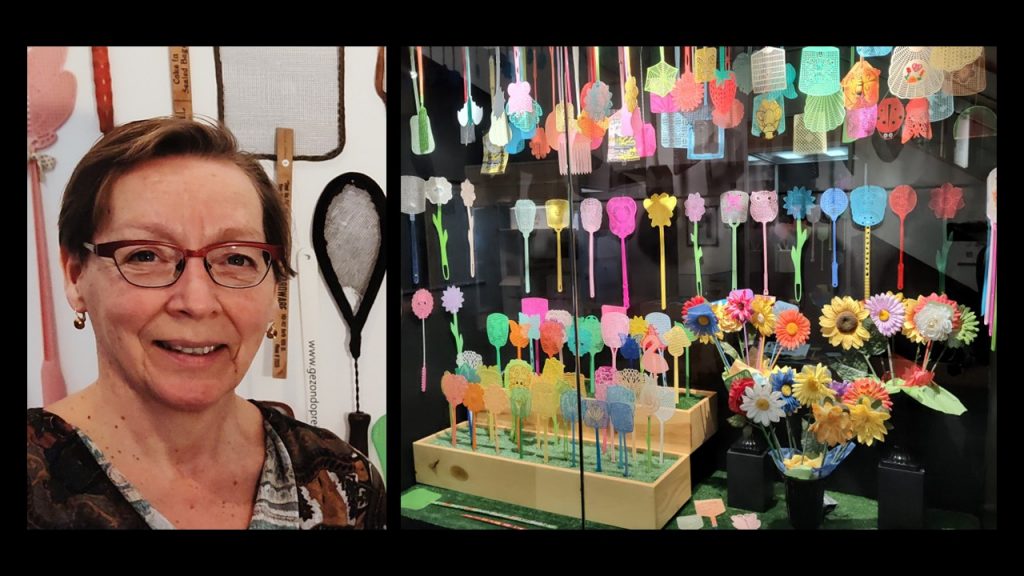
In the Netherlands a fly swatter is called a “vliegenmepper.” In Scandinavian areas “fluesmekker” is the name of the tool and in Germany it’s called a, “fliegenklatsche.” Iza’s oldest “vliegenmepper” is dated back to 1920.
But, if Iza’s from The Netherlands, how did her collection come to Kalamazoo?
Iza’s Connection To Kalamazoo
Kalamazoo native, Elisabeth (Liz) Rohs, had lived as an exchange student with Iza and her family in 1966. Their strong friendship has kept them connected over the decades. They have frequently visited one another. Liz had explained, “Everywhere we went, we looked for flyswatters. It’s just a funny thing to go into odd stores and look for flyswatters.”

Photo Credit: Second Wave Southwest Michigan
On one of Liz’s trips to the Netherlands, she had witnessed an amazing display of her friend’s fly swatters at a local museum. When Liz returned home she had contacted the Kalamazoo Valley Museum and organized the exhibition of her friend’s flyswatters for 2019. Pandemic circumstances had caused the exhibit to be postponed. Recently, after years of waiting, it was finally time for Iza and her husband, Nico, to bring the collection to the states. This wasn’t an easy task . . .
Getting Through Customs
Iza and her husband, Nico, had traveled from the Netherlands bringing 1,250 swatters. I learned from a Second Wave article. Nico had raised his brow about going through customs. “‘Well, 1,250 flyswatters,’ and they asked us, ‘Can you give the country of origin of each flyswatter?’ Well, we didn’t do that, it’s impossible.” He told Fran Dwight.

Photo Credit: Second Wave Southwest Michigan
Then the officials inspected the flywhisks made from African and South American animals’ tails. “What animals are they from?” I imagine an officer cocking an eyebrow. “Not ones from endangered species?” After some time, Iza and Nico along with their collection of fly swatters, were allowed to pass through. “It gave a little delay,” Nico had nodded.
Iza had said, “The Kalamazoo Valley Museum will be famous. It will be famous in the Netherlands because I am the first Dutch woman going with flyswatters to the United States!”
Fly Swatter History – Flabellum
Pharaohs, about 3,000 years ago, used animal tails called ‘Heka,’ ‘Ekhakha’ or ‘Flabellum’ to swat at flies. The name ‘Flabellum’ had referred to the celestial ox who carried special power. These ox tail tools had only been used by royalty.
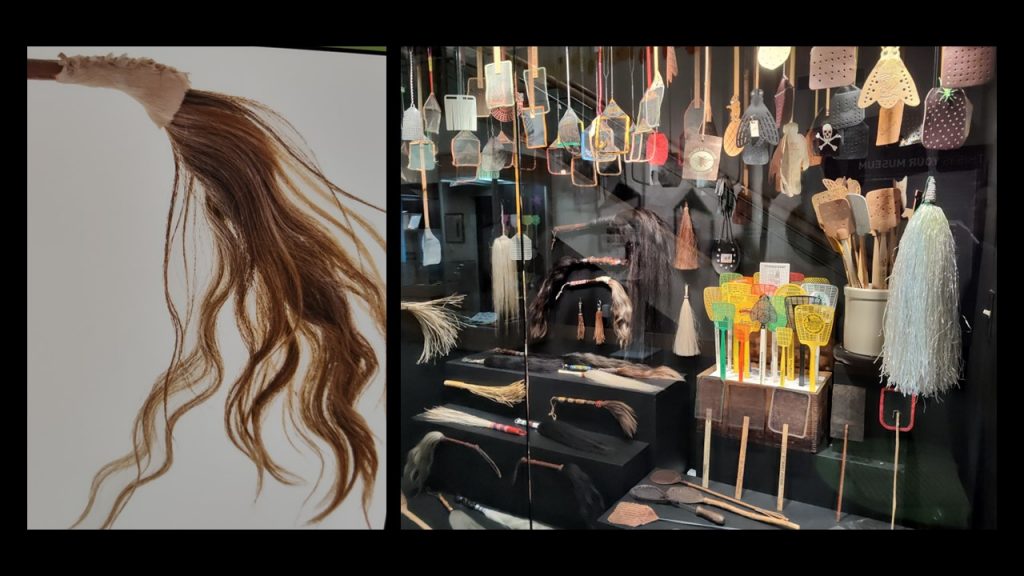
(Right) Various styles of fly swatters were standing proudly at the museum.
How Did The Fly Swatter Earn Its Name?
In the early 1900’s Robert R. Montgomery, who had lived in Decatur, Illinois, had patented the modern day “fly killer.” The netting was the key. It permitted airflow as the “fly killer” was whipped at the enemy insect. “It kills without crushing” and “soils nothing” was the 1901 Ladies’ Home Journal advertisement. These devices were soon marketed as “King Fly Killers” and “The Fly Bat.” Over a half million had been sold.
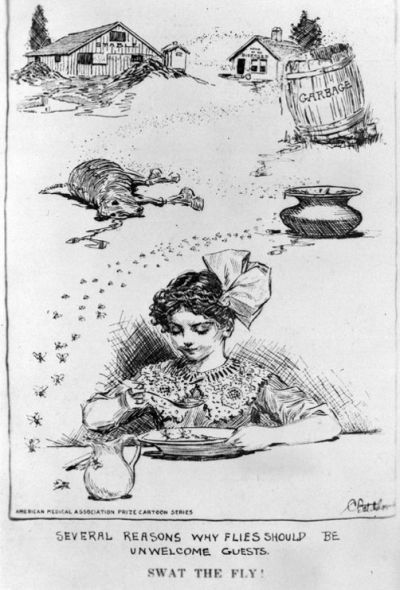
In 1905 Samuel Crumbine, secretary of the Kansas Board of Health, had attended a baseball game and heard the fans cheering, “SWAT THE FLY!” He used the slogan on his health campaign posters against the “unwelcomed guests;” flies.
North American Health Campaigns
Soon other states adopted the slogan, “SWAT THE FLY.” The term “fly swatter” had become a household name.
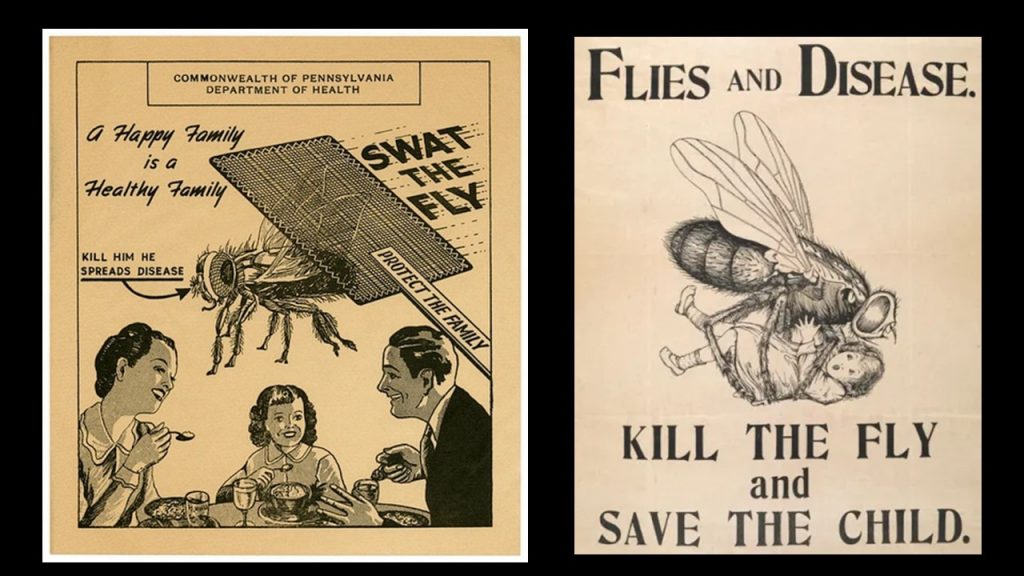
As I continued clicking on links about flies, I was stunned to read about a 1912 Toronto fly swatting competition by their health department. The $200.00 prize money would be distributed among the top contenders during the summer contest.
As one of ten children, 15 year old Beatrice White had hoped to use the funds for music lessons. She diligently baited the flies with a piece of liver tucked inside a box which had a cloth doused in insect power laid over it. She had caught over 500,000 flies and won first prize of $50.00. Nearby, Elva Baill, had collected over 200,000 flies from a manure pile and earned second place, $20.00.
I am sitting here cringing at the thought of kids picking flies off poison covered liver and a mounding manure pile. I’m also curious about the remaining $130.00 and how it had been distributed. Beatrice did report that her father had sadly taken charge of her prize money.
The Patent Gets Improved
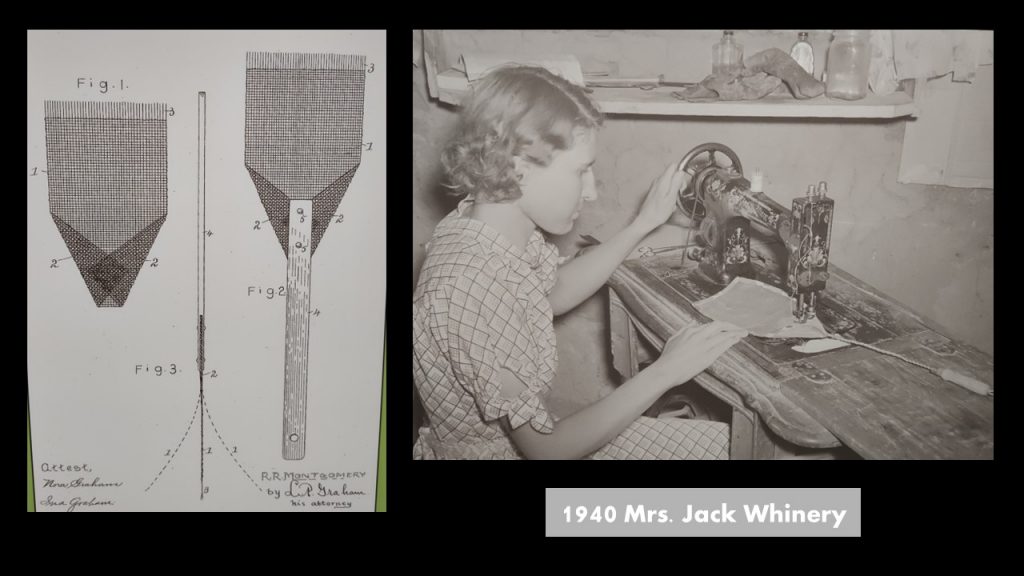
After having produced over a half million King Flykillers, the United States Wire Mat Company, headed by John L. Bennett, purchased the patent in 1903 and improved the design. By stitching around the perimeter of the netting the weight and durability had increased. Plus, the swatter was found to have more of a ‘snap’ when used.
Other Methods of Capturing A Fly
The Tanglefoot Company, based in Grand Rapids, had developed sticky fly tape which trapped the pests. Check out Chuck’s YouTube video at the end of this article in the “Related Links” section.

Venus Fly Traps, are hungry plants that digest insects. This has been an exotic method for keeping homes pest free.

A few have taken the stance that killing flies is wrong and have developed live traps so the bugs can be set free in outdoor surrounds. In fact, a live trap was exactly what The White House was sent following President Obama’s infamous ‘Hand Slap Killing’ of a fly which had happened on live television in 2009.
The President Kills A Fly

During a CNBC interview, President Obama killed a fly with his bare hands, triumphantly exclaiming, “I got the sucker!” PETA was less gleeful, calling it a public “execution” and sending the White House a device that traps flies so that they may be set free.
Ponderings
Flies and their nemesis, fly swatters, have both survived this awkward duality for more than a century. It’s been a curious journey diving into the realm. Thank you for coming along!
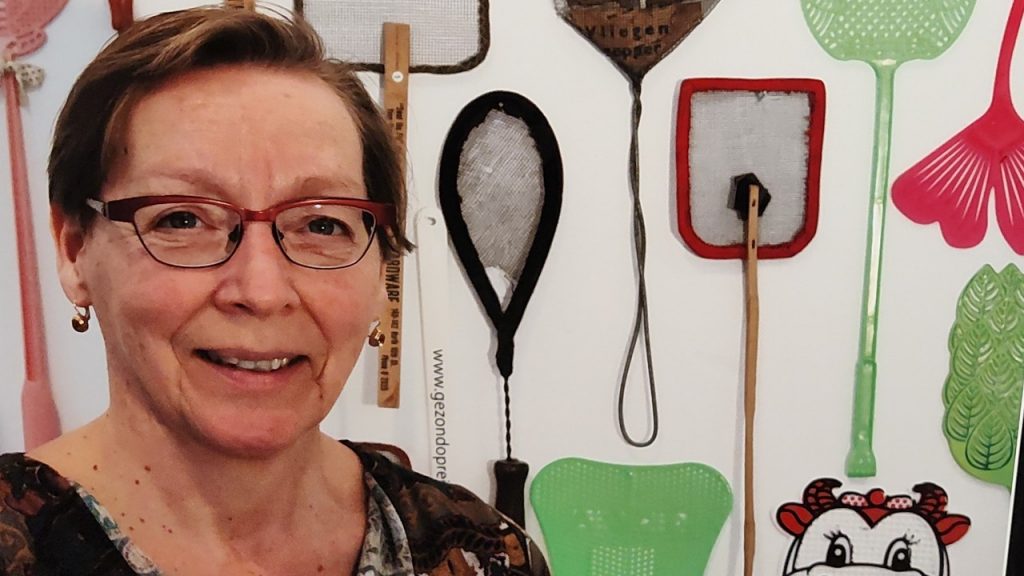
Photo Credit: Kalamazoo Valley Museum
Iza has sparked curiosity in all of us. Each fly swatter holds a story, as does the history of defeating the pesky bugs. Thank you, Iza van Riemsdijk, for sharing your passion and your collection! Your life long friendship with Liz is precious and a model for us all. Liz, thank you for organizing this exhibition! It will be at Kalamazoo Valley Museum until January 7th. Check it out!
Related Links:
Enjoy Chuck’s video about fascinating Fly Paper! The Tanglefoot Company in Grand Rapids, Michigan.
Restless Viking merchandise is available!
Resources:
The New York Times article 2012 “Who Made The Fly Swatter?” By Hope Reeves
Second Wave Southwest Michigan article by Fran Dwight published on Thursday, July 20, 2023
Wire Cloth website
From The Thing: Fly Swatter 1912 Competition article





